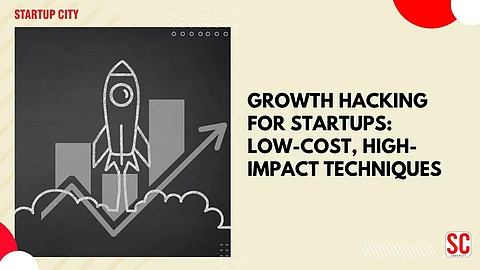

Growth Hacking for Startups
“Startup success can be engineered by following the right process, which means it can be learned, which means it can be taught.”
— Eric Ries, Author of The Lean Startup
Let’s face it — as a startup founder, you're constantly racing against time, resources, and competitors. You need results, but you don't have the luxury of million-dollar marketing budgets. Sound familiar?
Now, imagine achieving 10x growth with half the spend.
That’s the magic of growth hacking — the art of experimenting, optimizing, and scaling without blowing up your bank account. In my experience working with startups across India and globally, I’ve seen firsthand how scrappy tactics often outperform expensive strategies — if you know where to focus.
In this article, I’ll show you low-cost, high-impact growth hacking techniques that can help you scale faster, smarter, and leaner.
You’ve heard the buzzword. But what is growth hacking?
Growth hacking is not just marketing. It’s a mindset. It’s about combining data, creativity, and lean experimentation to unlock exponential growth — especially when your resources are limited.
Think of it as your unfair advantage.
Coined by Sean Ellis (the first growth hacker at Dropbox), this approach has helped companies like Airbnb, Hotmail, and Uber go viral without traditional advertising.
Whether you’re pre-revenue, bootstrapped, or VC-backed, these techniques can turn your startup into a growth engine.
Still wondering if it’s worth your time? Here’s why growth hacking for startups is not optional — it’s essential:
Cash is tight. Every rupee must deliver ROI.
Speed matters. You need traction yesterday.
Market validation is crucial. You must know what works — fast.
Traditional marketing is too slow and expensive.
If you're building a startup in India’s hyper-competitive ecosystem, you already know this. But the good news? You can still win — if you get creative.
Imagine turning every user into a promoter.
Dropbox famously offered extra storage for every referral. Airbnb grew by enabling users to post listings on Craigslist.
Try this:
Add share incentives (e.g., refer and earn)
Make sharing part of the product journey
Use waitlists (like Clubhouse) to create FOMO
Pro tip: Viral loops only work if your product solves a real pain point. No gimmick can replace that.
In my experience, many startups overlook this — data is free, and insights are gold.
Use tools like Google Analytics, Hotjar, and Mixpanel to:
See where users drop off
Track conversions by channel
Test headlines, CTAs, and onboarding steps
Action step: Run A/B tests every week. Even tiny tweaks (button color, placement, offer wording) can unlock 2x conversions.
“In God we trust. All others bring data.”
— W. Edwards Deming
Startup founders wear multiple hats. That’s why automation is your best friend.
Here’s what I recommend automating first:
Onboarding emails (use Mailchimp or Sendinblue)
Customer support FAQs (chatbots like Intercom or Drift)
Lead generation (LinkedIn tools like Phantombuster, Apollo)
You don’t need a big team. Just smart systems.
Your audience is already hanging out somewhere — go there and give value.
Let me show you how:
Post insightful threads on LinkedIn and X (formerly Twitter)
Answer questions on Quora or Reddit (without being salesy)
Join founder/industry-specific WhatsApp or Discord groups
Repurpose blog content into micro-videos, reels, or infographics
And don’t underestimate the power of long-form SEO content (like this one).
Building in public means sharing your startup journey openly — wins, failures, all of it.
It:
Attracts early adopters
Builds trust with investors
Helps you stand out from the noise
Use platforms like LinkedIn or YouTube. Let people root for you.
Your story is your strongest brand
Ever heard of “Give before you ask”?
Offer real value upfront:
A free tool or calculator
A checklist, PDF, or mini-course
A niche report or eBook (like “Startup Fundraising in India 2025”)
Gate it behind a simple email form — and boom, you’ve got leads.
Keep it simple. Keep it irresistible.
Startups often try to “market” before they listen.
Instead:
Talk to 100 users (really talk)
Join their communities
Understand their struggles
Then position your product as the solution
This mindset shift alone can 3x your conversions. You’re not selling features — you’re solving pain points.
This is one of my favorite growth hacks — and it’s 100% free.
How?
Partner with micro-influencers
Do guest posts on niche sites
Run webinars with relevant communities
Cross-promote with complementary startups
You're not alone. Leverage others who already have your audience.
“It’s not about having resources. It’s about being resourceful.”
— Tony Robbins
Ever visited a website and saw the same ad later on Instagram? That’s retargeting.
Use Meta Pixel and Google Ads to retarget visitors who:
Abandoned your signup page
Read your blog but didn’t convert
Watched 50% of your product video
Start with just ₹500–₹1000/day — it works like magic.
Zerodha – Grew organically using educational content and community trust instead of ads.
CRED – Used exclusivity and referral tactics to go viral.
Razorpay – Created value-led resources like guides, reports, and fintech news updates to attract B2B leads.
Dunzo – Partnered with hyperlocal businesses and leveraged witty content marketing.
These aren’t unicorns because they spent big. They grew because they hacked growth — smartly.
Ask yourself:
Where is my biggest bottleneck — traffic, signups, or retention?
Which channel fits my product best — content, referrals, partnerships?
What can I test this week without waiting for approval?
Pick one idea from this article and run with it. Today.
You don’t need a million-dollar ad budget. You don’t need a 50-member team.
What you need is the right mindset, some grit, and a few smart experiments.
So the next time someone says “growth hacking is just a buzzword,” smile — because you know it’s your secret weapon.
Now go hack that growth.